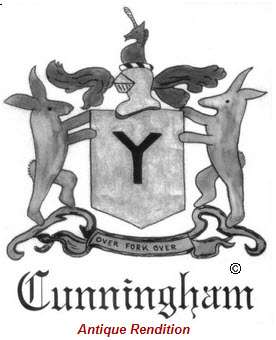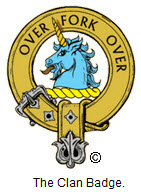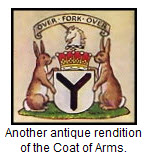Coat of Arms

.jpg)

The Cunningham Coat of Arms is a pictorial description of an event in the life of the first man to bear the name of Cunningham. It consists of a silver shield on which is displayed a black shake fork (a farm implement) supported by two brown rabbits or hares (cunnings). The shield is the most important part of the Coat of Arms (or Arms of Achievement) because on it are displayed the devices of the name to which it belongs, and it is with the shield that the laws of heraldry are concerned. It is impossible to have a coat of arms without a shield. Surmounting the shield is a silver helmet lined with red velvet. The mantling was a piece of leather or cloth attached to the helmet and used as protection from the heat of the sun and from the rain, which would have rusted the moveable parts of the helmet, but has no significance as to the rank of the one who wore it. The crest is a unicorn's head. Below the shield is a blue ribbon with the motto, "Over Fork Over". The motto was associated with some gallant deed that brought prime importance to the clan (or family). Friskin, the first Cunningham, placed straw over the Prince Malcolm to hide him from his enemies, thus saving his life, and the shake fork with the words "Over Fork Over" signified this act. Our William Cunningham knew well the Arms of Achievement for his family, and also for the Dalrymple Arms of Achievement because these were the Scottish customs that he had to obey because his families were in nobility; the Dalrymple because his paternal grandmother was the daughter of Sir David Dalrymple, whose title was Lord Hailes.
A Brief History of the Cunningham Name
The Scottish surname Cunningham is local in origin, being derived fom the name of the place where a man once lived or where he once held land. In this case, the surname derives from a place called Cunningham in the northern district of Ayrshire on the west coast of Scotland. The name is now widespread throughout Scotland and elsewhere, its old families having divided into many branches. It is even quite numerous in France, where it was carried at an early period by Scottish emigrants.
There are several variant spellings of the surname, including Cuninghame, Cunninghamme, Cunnyngham and Coninglants. It first appears in Scottish records during the twelfth century, when a person by name of Wernebald obtained the manor and vill of Cunningham from his feudal superior and adopted his name as his own. There are many subsequent references to the name in Scottish records, and its local origin is confirmed by the fact that many of these are prefixed by the proposition "de", meaning "of". In 1190 an Alexander de Kuningham was witness of the grant of Kirkbride Largs to the nuns of North Berwick and Sir William de Conyngham appears as dominus de Kylmawrus in 1370. William de Cuningham, vicar of Dundonald, was threatened with excommunication for intruding himself into the affairs of the Poor House of Polmadie in 1403.
A Brief History of the Coat of Arms
Coats of arms are not awarded to a family or a name, but to an individual. This is why there is often more than one coat of arms associated with a given surname.
The coat of arms was actually the linen surcoat worn over the armour to protect it from the direct rays of the sun. In the heraldic period this garment came to be decorated on the front and back with the arms exactly as they were on the shield.
Most people use the expression coat-of-arms quite indiscriminately to indicate either a shield (in which case they are using it more or less accurately), or the crest, or else the whole heraldic achievement, which is the shield with all its adjuncts, and in the last two cases the term coat-of-arms is wrong. The current expression for the whole thing is the "achievement". An achievement normally consists of the shield, helmet, mantling, wreath, crest, supporters, and motto. A coat of arms normally consists of the shield.
The shield proper is the warrior's piece of equipment that designates who he is. For that reason, the armorial insignia which depicts a warrior's ancestry as well as his individual identification is displayed here. All other acouterments such as the crest, mantling, and supporters serve merely to enhance and draw attention to the armorial insignia. The shield may be of any form, with the exception of the diamond shape, termed the lozenge, which is the only form women may use, and is therefore reserved for them. This lozenge often with ther husband's insignia, is displayed as a badge on clothing or appropriate possessions and reflects her husband or father's honor. Women descended from noble houses on their own account may have their insignia displayed alongside her husbands in a "quartering" of the lozenge, where the two families insignia or "arms" are displayed in alternating quarter panels of the shield.
The arms of the family were embroidered on the mantels of the women. There were rules how the men were to wear the crest, and the motto on shoes, trouser buckles, and head dress. When a ship left port the shields of all arms-bearing men aboard her were painted on her sides. Seals bearing the owner's arms were stamped on documents. Every member of an arms bearing household was required to have a knowledge of heraldry and be able to recognize the arms of prominent men of their time, and the arms of their lord's friends, and of more importance, of his enemies.
A Brief History of the Clan Badge

Gaelic tradition allows family members to use the "crest" part of an entire coat of arms (that which appears above the shield) in a badge setting (a circular belt), thus all members of a given clan are entitled to use the clan badge. Indeed, the crest part of a coat of arms has been used on engravings, rings, bookplates, and other means of displaying one's heritage for many years. Perhaps this is due to their relative simplicity in relation to the full coat of arms. (The Cunningham Clan Badge is pictured at right)
The Blazon of Arms
Blazon means the written desciption of a coat of arms, so precise,as to allow the reader to imagine the arms without any other assistance. Argent a shakefork sable,a unicorn's head crest couped argent armed or, Over Fork Over motto.
The Meanings Behind the Symbols
Please note that the following descriptions and meanings are gleaned from a variety of sources, some of which disagree on those meanings. The most commonly accepted meanings are given, but scholars vary in the their opinions concerning the reliability of any "commonly held" historic meanings for coats of arms and crests.
Shield "Metal" Color Silver (Argent) - Peace and Sincerity (All shields have a metal color, and hue colors. The metal colors are silver and gold. Gold is usually reserved for royalty.)
Shield "Hue" Color Black (Sable) - Constancy or grief

Ribbon Color Blue (Azure) - Truth and loyalty
Hare (Rabbit) Supporters - One who enjoys a peaceable and retired life
Unicorn Crest - Extreme courage; virtue and strength
The Charges are the objects placed upon the shield (in this case the shakefork).
These objects are the signs and emblems of the family to which it pertains.
The Helmet varies with the bearer's rank or the century. Shown in profile, with a closed visor, denotes an Esquire's or Gentlemen's helmet. The helmet is always lined with red velvet.
The Wreath is the rolled cloth placed atop the helmet, and is always shown in six parts. It is usually in the colors of the primary color and metal color of the shield, thus for ours it would be silver and black. It has no significance, except to hold the mantling in place.
The Mantling was a piece of cloth or leather attached to the wreath, and used as to protect the back of the head and neck from the heat of the sun, and from the rain, even though it may often be depicted more like the leaves of a plant.
The Shield - The background of the shield is called the field, and the objects upon it are called the charges. The Cunningham shield is in the heater shape.
The Motto - "Over Fork Over" - In Scotland, the motto is a part of the grant of the arms, and must be used without change, and is hereditary. The motto of a family was associated with some gallant deed which shed lustre on the clan (family). The first Cunningham put straw over the Prince of Scotland and the shake fork with the words "Over Fork Over" signified this kind act.





Copyright Cunningham Family Website - All Rights Reserved